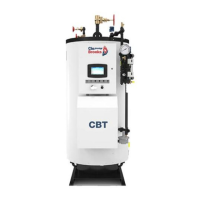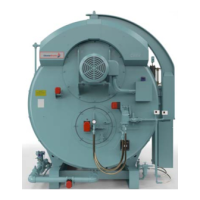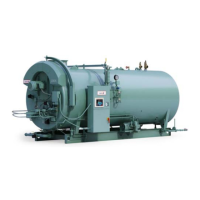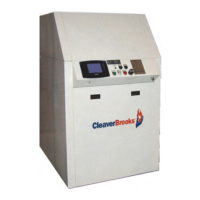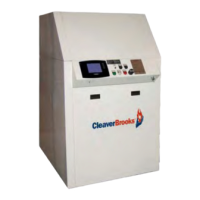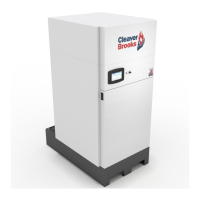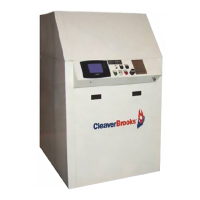Adjustment Procedures
6-12
750-91 (revised 2009)
Model CB-LE Packaged Boiler Manual
7. To make the final adjustment, slowly close the gas pilot adjusting cock until the flame can no longer be seen
through the sight tube. Then slowly open the cock until a flame providing full sight tube coverage is observed.
The adjustment must be accomplished within the time limit of the safety switch or approximately 30 seconds
after the detector is removed. If the control shuts down, manually reset it. Replace the detector and repeat the
process from step 6.
8. When a suitable flame is obtained, replace the detector. Observe the reading on the micro-ammeter. The read-
ing should be between 2-1/4 and 5 microamps when using a lead sulfide detector and a standard amplifier. See
the flame signal table in the manufacturer's bulletin for values of other combinations.
The flame signal indicated on the annunciator type relay should not be less than 10 Vdc, and may be as high as
20 Vdc or greater.
The reading must be steady. If the reading fluctuates, recheck the adjustment. Be sure that the flame detector is
properly seated and that the lens is clean.
9. Return the test switch to the RUN position.
10. If main flame has not been previously established, proceed to do so in accordance with proper instructions.
11. The reading of the main flame signal should also be checked. Observe the flame signal for pilot alone, pilot and
main burner flame together, and the main burner flame at high, low, and intermediate firing rate positions.
Readings should be steady and in the range indicated in Step 8. If there are any deviations, refer to the trouble-
shooting section in the technical bulletin.
6.16 — Gas Pressure and Flow Information
Because of variables in both the properties of gas and the supply system, it will be necessary to regulate the pres-
sure of the gas to a level that produces a steady, dependable flame that yields highest combustion efficiency at rated
performance yet prevents overfiring. Once the optimum pressure has been established, it should be recorded and
periodic checks made to verify that the regulator is holding the pressure at this level. Occasional modification in
fuel composition or pressure by the supplier may, at times, require readjustment to return the burner to peak effi-
ciency. Since the gas pressure regulator itself is usually furnished by others, detailed adjustment instructions and
adjusting procedures recommended by the manufacturer should be followed.
6.16.1 — Pressure
The gas supplied must provide not only the quantity of gas demanded by the unit, but must also be at a pressure
high enough to overcome the pressure-loss due to the frictional resistance imposed by the burner system and the
control valves.
Wear a protective shield or suitable glasses and keep eyes sufficiently away from the sight tube opening to avoid serious
personal injury. Never remove the flame detector while the main burner is firing.
When checking the pilot flame, be aware the electrode is energized.
Failure to follow these instructions could result in serious injury or death.
!
Warning
